Advancing Long-Term Energy Planning in Central and Eastern Europe
The EU and its Member States are setting their climate ambition for 2040 – a crucial milestone for accelerated action on the path to climate
The EU’s long-term budget, the so called Multiannual Financial Framework (MFF), sets the spending priorities for the annual EU budgets over a seven-year period. It greatly translates the EU policy objectives into action. It defines objectives, priorities and conditions of EU funding respectively the policies EU funds are supposed to finance.
The EU budget 2021 – 2027 is critically important to deliver the long-term climate goals of the EU, including the revamped 2030 climate and energy targets and climate neutrality by 2040.
The 2014-2020 EU budget had some important climate-relevant features such as “climate mainstreaming”, the strategic link to the EU 2020 climate and energy framework or the political target to spend 20% of the EU budget on climate action. However, fossil fuels still received support from the EU budget, and competing priorities and incoherent implementation of climate action are sweeping off the climate credits of the EU budget. Overall its full potential to catalyse the clean energy transformation in Europe remained largely untapped.
LEARN MORE about the reform opportunities and climate impact of the EU budget.
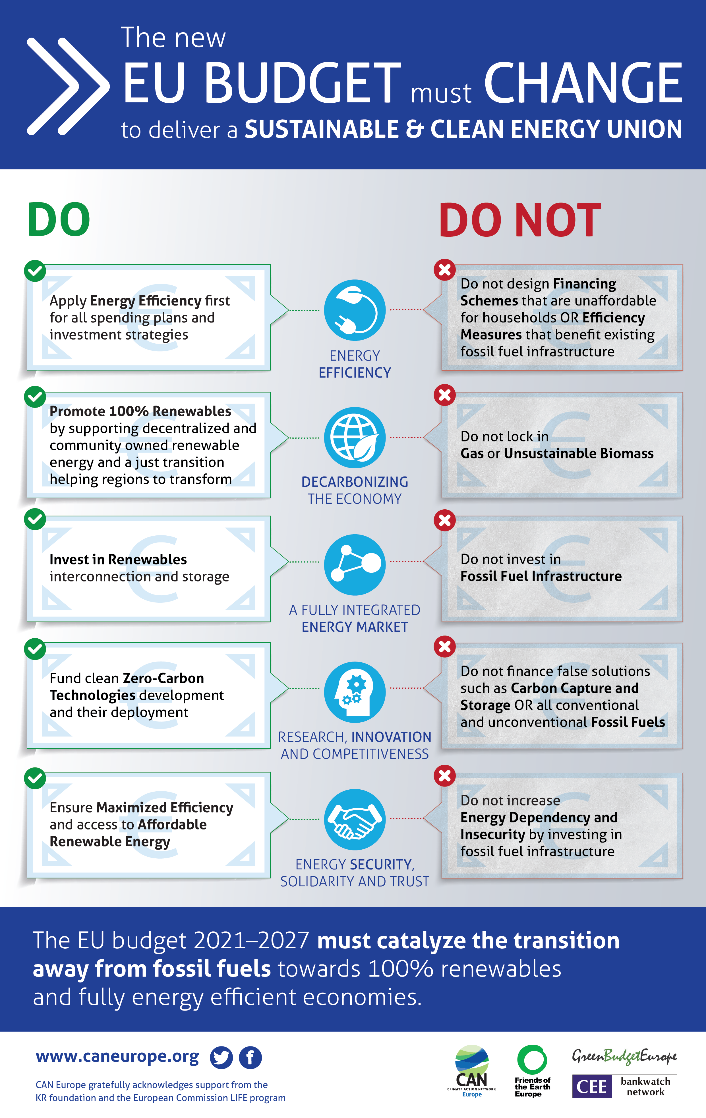
The EU budget 2021–2027 shows increased climate ambition with an increased climate action target across all EU programmes and the limitation of fossil fuels from Regional Development Funds. A fossil fuel free Just Transition Fund will help carbon intensive regions to become climate neutral.
To meet the goals of the Paris Agreement, the European Union needs to achieve net zero greenhouse gas emissions by 2040. EU funds must support the decarbonization of all sectors by developing zero-carbon processes and products, enable the just transition, establish a genuine circular economy and foster a transition towards sustainable food systems.
Overview EU funding for climate action
The upcoming development of EU funds’ spending plans at national and regional level as well as for the additional ‘economic recovery plans’ – the ‘programming’ – will ultimately determine the direction of the recovery and future economic developments.
Decision making on the implementation of the next EU budget including the significant amounts of recovery funding is therefore crucial to put the EU on a pathway towards climate neutrality. Investment decisions taken to stimulate the economy need to contribute to achieving more ambitious 2030 climate and energy targets at the same time.
EU financing also needs to embrace the long-term transition to climate neutrality as set down in the European Green Deal. Greater investments in the transition of all sectors of the economy are needed to ensure a sustainable, green and just economic recovery and to shape the EU’s long-term pathway to achieving the Paris Agreement’s objective of limiting global temperature rise to 1.5°C.
In order to maximise the impact of EU funding, both to increase climate ambition and to ensure the recovery is sustainable, Member States need to direct their upcoming spending plans towards climate neutrality.
During the programming of Partnership Agreements and Operational Programmes under Cohesion Policy, in the development of Territorial Just Transition Plans within the Just Transition Mechanism and while setting priorities for Recovery and Resilience Plans to receive support from the EU’s Recovery Fund, Member States must seize all funding opportunities to catalyse the green, sustainable and just transition, whereas any climate and environmentally harmful spending has to be prevented.
Learn more about the green programming priorities in 14 EU countries.
The EU and its Member States are setting their climate ambition for 2040 – a crucial milestone for accelerated action on the path to climate
CAN Europe has submitted two responses to public consultations on the Ten-Year Network Development Plan (TYNDP) 2026 Scenarios that aim at providing a basis to
The upcoming Citizens Energy Package presents a unique opportunity to put people, not fossil fuels, at the center of Europe’s energy future. It is intended
The COVID-19 pandemic and economic crisis is converging with the increasingly evident climate and biodiversity crises. Global warming and ecosystem deterioration are laying the ground for future upheaval of society. While the recovery measures must address the immediate health, social and economic urgency, they must support the development of a resilient and sustainable economy, in line with the Paris Climate Agreement and the European Green Deal.
Business as usual is not an option, and economy-wide untargeted measures would risk resuscitating dying and polluting industries and technologies that have no room in our future carbon-neutral economy.
Instead, the economic recovery measures must support ‘future-proofing’ companies through a rapid shift of their business models towards decarbonisation, thereby ensuring a much higher return on public investment.
Learn more about CAN Europe Urgency Plan for the Climate and Economic Recovery.
Reacting on calls for a wide response the EU adopted – as part of the overall EU budget – a financial package ‘Next Generation EU’ aiming to address the economic upheaval.
Despite some positive elements, the recovery package falls short of making climate ambition and the phase out of all fossil fuels the “new normal”.
The EU’s recovery efforts in a nutshell
Learn more about the deficits and opportunities of the EU’s recovery funding.
This is important to pave the way for an EU agreement by the end of this year on a substantially increased 2030 climate target of at least 65% emission cuts, to achieve climate neutrality by 2040, and to ensure recovery from the crisis is sustainable, supports green job creation, the just transition, and future-proofs the EU economy and livelihoods.
The Sustainable Europe Investment Plan (SEIP) is the financial arm of the European Green Deal, created for financing European economies’ transition to zero-carbon emissions and expected to mobilise at least €1 trillion over the next decade. A key element of the plan is the creation of a Just Transition Mechanism (JTM) aimed at supporting those carbon-intensive regions of the EU – such as coal-mining areas – where moving to climate neutrality will be more complex.
The transition to a climate-neutral economy means learning new skills, innovating and implementing new technologies, renewing our infrastructure and cutting dependence on fossil fuels.
It requires not only more investments, but better, transformational investments, and great attention to issues of governance, namely the creation of an enabling regulatory and institutional environment. It will require additional investments in all sectors and areas of society.
This Overview of EU funding sources to build climate-neutral economies lists those EU funding sources with a potential to catalyse the transition to climate-neutral economies: it displays the various financing and funding instruments which are sourced and legally based at the EU level. Further on it highlights various opportunities for financing soft-measures, technical assistance and capacity building, needed to create a favourable investment environment.
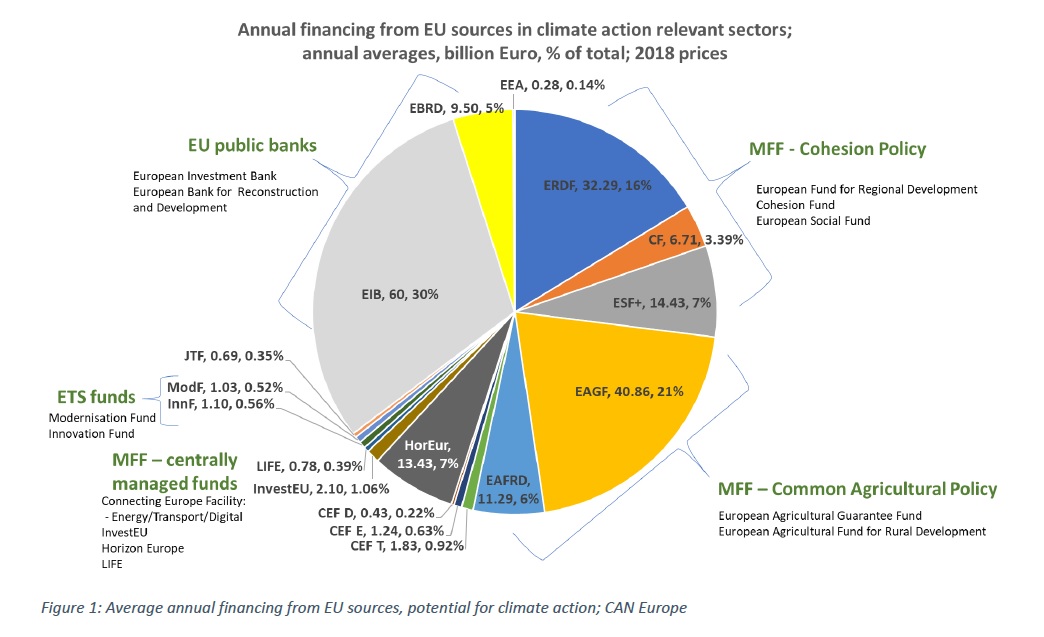

The upcoming Citizens Energy Package presents a unique opportunity to put people, not fossil fuels, at the center of Europe’s energy future. It is intended

Brussels, 10 June 2025. As the Commission moves forward with a deregulation drive in favour of corporate interests, Climate Action Network (CAN) Europe today co-organised
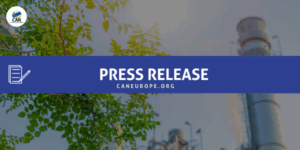
Brussels, 3 June 2025 — One hundred days after the launch of the Clean Industrial Deal (CID), implementation of the EU’s flagship initiative to decarbonise
Fossil fuel combustion – coal, oil and gas – is by far the largest contributor to global climate change, accounting for 80 per cent of greenhouse gas emissions globally. Fossil fuel subsidies have infiltrated all sectors of our economy and are now pervasive, multiform and massive. These subsidies directly hinder the efforts to transition to 100% renewable energy.
In the EU, the overwhelming majority of fossil fuel subsidies are at national level, but recently adopted EU legislation opens the door again to fossil fuel subsidies for oil and gas infrastructure that would lock us in fossil fuels for many years, while gas boilers remain eligible for support in several EU funds.
Whether they relate to production or consumption, fossil fuel subsidies are damaging people and the planet, in many cases, they benefit the wealthiest, they are preventing the energy transition towards renewable energy systems, damaging public health (air pollution) and hampering the achievement of emissions reduction goals.
CAN Europe urges to end subsidies benefiting the wealthiest without further delay, and to support people working in the sectors impacted in the transition. Job growth in new energy transition sectors, more than offsets a decline in traditional fossil fuel supply sectors. However, state schemes should ensure the working conditions do not deteriorate, collective bargaining should organise the transition to new jobs and the role of trade unions needs to be promoted and protected in the new green sectors.
According to CAN International, at the global level, all fossil fuels need to be phased out by 2050 worldwide, shifting to 100 % renewable energy sources. For CAN Europe, the Paris Agreement-compatible fossil fuel phase-out in the EU means an end by 2030 for coal, 2035 for fossil gas, and 2040 for oil, at the latest.
The hidden cost of fossil fuels for the environment, climate and public health require urgent action in many areas, from international finance to trade, fisheries, agriculture, transport, industry, taxation, budget, finances, state aid, housing, social protection, education and skilling, and energy and climate of course. Ending fossil fuel subsidies is everyone’s business in each and every national ministry and at the EU level.
Main publications:
How to stop the never-ending nightmare: New report tracks fossil fuel subsidies in the EU
Phase-out 2020: Monitoring Europe’s fossil fuel subsidies (September 2017)
Europe in motion – Ending all public financial support for fossil fuels (October 2017).
Important investments are needed to decarbonise Europe’s economy and keep global temperature rise below 1.5°C . The EU economic governance framework was designed 30 years ago and is outdated to meet today’s societal challenges.
There is an urgent need to transform our economies and societies to address the climate, environmental and social justice challenges. The EU economic governance framework, and the Stability and Growth Pact in particular, need a deep reform in order to be aligned with the objectives of the European Green Deal and the Paris Agreement.
Read CAN Europe position on the need to reform the EU fiscal system
Other resources:
• 25/03/2024 Statement | Fiscal Follies: How new EU rules miss the mark on climate and prosperity
• 09/11/2023 Opinion Editorial | The imperative of reforming EU economic governance
• 16/06/2023 Report | FROM MAASTRICHT TO PARIS: Why climate change should be considered in a reformed EU fiscal framework
• 07/06/2023 Letter | Letter: A climate perspective on the European Commission’s proposals to reform the EU economic governance framework
• 01/08/2023 Opinion Editorial | Climate crisis calls for U-turn in EU’s economic governance EN / FR
• 15/03/2022 Statement | Manifesto for a green, just and democratic European economy
• 11/03/2022 Analysis |Will the war in Ukraine be a game changer for the EU economic governance?
• 29/11/2021 Public Consultation | CAN Europe response to a public consultation
• 18/10/2021 Opinion Editorial | Fiscal reform and why it matters?
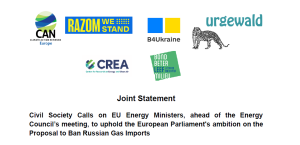
On Monday, October 20, EU Energy Ministers will meet for a critical discussion on the proposed REPowerEU Regulation, which aims to phase out Russian fossil

On October 13, 2025 CAN Europe has submitted response to the call for evidence opened by the European Commission on the Revision of the EU
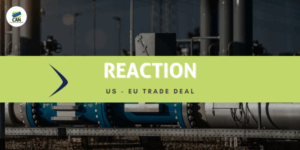
Brussels, July 28 – CAN Europe’s reaction to the US-EU trade deal announcement: Esther Bollendorff, Senior Gas Policy Coordinator, CAN Europe: “The new US-EU trade
Ensuring that the EU and Member States have sufficient funds for filling the climate and nature investment gap will require a huge improvement in the quality of public spending (ending fossil fuel and other environmentally harmful subsidies), but also the raising of income. In particular, the EU will need new own resources (i.e. EU-wide revenues) in order, first to reimburse the EU debt that underpins the establishment of Next Generation EU (NGEU), and second to finance a new EU green and social investment plan post-2026. Beyond the finance dedicated to meeting the EU’s climate targets and financing the socio-ecological transformation, there are also significant gaps in meeting international climate finance commitments. New resources for Member States and/or the EU can be raised through a coordinated introduction of new national taxes or the direct introduction of EU-wide taxes. Whilst several proposals have been tabled both by the European Commission and the European Parliament, and should be further pursued, we consider that new own resources should be based on socially just progressive taxes and the polluter-pays principle.
Documents:
In June, several countries launched a platform of action to tax premium travels and private jets during the Fourth International Conference on Financing for Development (Seville, Spain). Ahead of
(Brussels, 10 October 2025) Climate Action Network (CAN) Europe warns that today’s decisions by EU Finance Ministers fall far short of what is needed to
As EU finance ministers met to approve Council Conclusions on international climate finance at the Economic and Financial Affairs Council on Friday 10 October, CAN
There are many myths around the topic of taxing the extreme wealth—but support for taxing the super-rich is growing. Taxing the wealthiest is a crucial
16 July 2025 — Today, the European Commission presented its proposal for the next Multiannual Financial Framework (MFF), laying out a draft of the spending
The CAN Europe’s MFF Green Investments tool shows where green investments are going in one of the most important instruments of the EU’s Multiannual Financial
CAN Europe Headquarters
Mundo B
Rue d’Edimbourg 26
1050, Brussels
Belgium
Tel: +32 (0) 28944670
CAN Europe empowers civil society organisations to influence the design and development of effective climate change policy in Europe, both in the European Union as well as in its Member States and in European countries outside the EU.
© Copyrights 2025. All Rights Reserved.